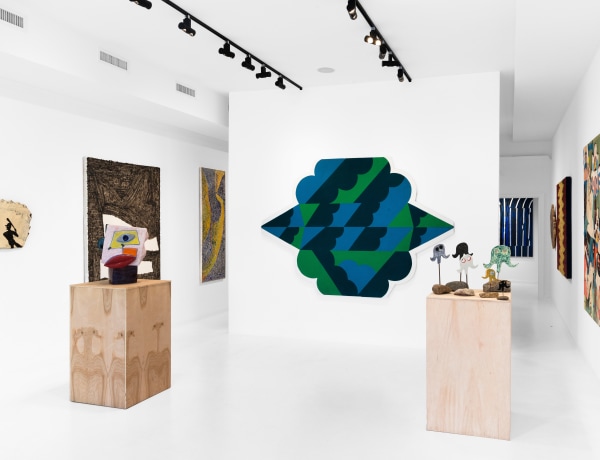

B. NEWARK, NJ, 1946
Throughout the last six decades, Nina Yankowitz has created daring and dynamic works of abstraction imbued with her formal and social justice concerns. A founding member of the iconic feminist collective Heresies, Yankowitz since the 1960s has worked across and beyond traditional art forms. Whether taking radical approaches to painting or mounting ambitious multimedia installations, Yankowitz has probed the material, political, and even sonic nature of abstract art.
Born and raised in New Jersey, Nina Yankowitz would skip class in high school to hang around legendary folk music venues in Greenwich Village. By word of mouth, Yankowitz learned of Group 212: a collective of artists, musicians, and poets with whom she spent the summer of 1968 in Woodstock, New York (which became the site of the famed Woodstock Festival). Group 212’s collaborative spirit, and liberal mixing of music and art, inspired Yankowitz to embrace emerging technologies and media. Sound especially came to underpin her practice.

Nina Yankowitz
Canvas Paint Swatches, 1969
Acrylic spray with compressor on canvas and bolts
156h x 72w in
396.24h x 182.88w cm
NYAN014
Yankowitz studied at Temple University and the New School for Social Research before graduating in Fine Art from the School of Visual Arts. Leaving behind painting’s drum-taut support, the Draped Paintings are unstretched canvases that she sprayed with mists of acrylic paint—producing abstract atmospheric expanses and bleeding bands of color. She then hung these works in loose soft folds that cascade vertically down or horizontally across the wall. The artist created her Pleated Paintings in a similar way, yet instead ran lengths of canvas through pleating machines before spraying them with paint. By eschewing the historical precedent of wood stretcher bars, these adaptable paintings assume various forms and identities each time they are installed. The artist installed her Draped and Pleated Paintings in 1967 and 1968 at the renowned Kornblee Gallery, where she later presented important solo shows between 1969 and 1971.
Only a few years after graduating from the School of Visual Arts, Yankowitz was invited to participate in the inaugural 1973 Whitney Biennial. During the mid-1970s, she began attending meetings with a group of feminist artists and writers that would become the Heresies mother collective, producing Heresies: A Feminist Publication on Art and Politics from 1977–93. The group sought to challenge patriarchal art institutions and systems.
In 1973, Yankowitz moved from her Tribeca studio to a loft building on Spring Street in lower Manhattan, where she began another important series. To create Dilated Grain Readings, the artist squeezed paint from plastic bottles onto unstretched raw linen that she had woven with tight and loose grain patterns for outlining with paint. They seem like color notated musical scores. Indeed, sound informs some of her work. As Yankowitz once explained, “When I hear sound I see color, and when I see color I hear sound.”
During that period, Yankowitz’s works were exhibited and reviewed alongside contemporaries such as the late Sam Gilliam. Like Gilliam, Yankowitz expanded on Abstract Expressionism, pushing the movement to encompass dramatically new forms and modes of presentation. Yet Yankowitz also introduced principles from the Feminist Art Movement into her practice. She incorporated sewing, pleating, and other handicraft techniques maligned as feminine into her painterly process—challenging the notion of “women’s work.”
Yankowitz used non-representation as a vehicle for her sociopolitical concerns. Her embracement of abstraction set her apart from some other feminist artists. As Yankowitz explained: “At the time, I didn't believe you had to reference female issues only by using female-specific imagery to be a feminist artist. But later, looking back to working with Heresies, I recognized the importance of projecting a strong unified voice demanding equal acceptance for a female imagery was necessary to make any change.”
Since the 1970s, Yankowitz has been a staple of the booming postwar art scene on the East End of Long Island. During the ‘70s, Yankowitz spent long periods of time in Southampton at the summer rentals of friends such as artist Hermine Freed and architect James Ingo Freed, and artist Marjorie Strider. The sonic environment there influenced facets of her practice. Yankowitz recalls being struck by the melodies produced by birds and insects, in response to which she created a series of painted scores and audio recordings that evoke the symphonic-like sounds of various voices. Eventually she purchased a house in Sag Harbor in 1993. The artist now lives and works in both Sag Harbor and New York City.
Yankowitz’s works are found in public collections including the Franklin Furnace Collection at The Museum of Modern Art, New York, NY; Guild Hall, East Hampton, NY; Fine Arts Museum of San Francisco, San Francisco, CA; Virginia Museum of History & Culture, Richmond, VA; and the Smith College Museum of Art, Northampton, MA. Her archival materials are found in the Archives of American Art, Smithsonian Institution, Washington, D.C..
Yankowitz has been featured in exhibitions or presented installations at institutions such as The Aldrich Contemporary Art Museum, Ridgefield, CT (1970); Emily Lowe Gallery, Hofstra University, Hempstead, NY (1970); Art Institute of Chicago, Chicago, IL (1972); Kunsthaus, Hamburg, Germany (1972); Storm King Art Center, New Windsor, NY (1973); Bronx Museum of Art, New York, NY (1978); MoMA PS1, New York, NY (1982); 51st Street Lexington Avenue Subway, commissioned by the Metropolitan Transportation Authority, New York, NY (1987); Katonah Museum of Art, Katonah, NY (1990); The Bass Museum of Art, Miami, FL (1996); Art in General, New York, NY (1998); Parrish Art Museum, Water Mill, NY (1998); Guild Hall, East Hampton, NY (2005; 2014); Museum of Modern Art of Ukraine, Kyiv, Ukraine (2011); The Museum of Modern Art, New York, NY (2013); and the Smith College Museum of Art, Northampton, MA (2016), among many others. She will be the subject of a major retrospective at the Museum of Fine Arts, St. Petersburg, FL, opening in the summer of 2025.